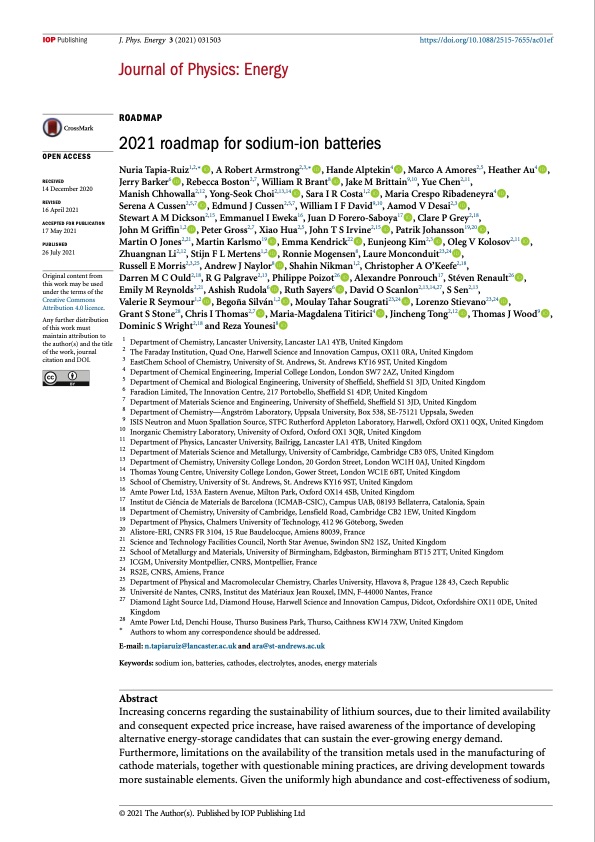
PDF Publication Title:
Text from PDF Page: 002
OPEN ACCESS RECEIVED 14 December 2020 REVISED 16 April 2021 ACCEPTED FOR PUBLICATION 17 May 2021 PUBLISHED 26 July 2021 Original content from this work may be used under the terms of the Creative Commons Attribution 4.0 licence. Journal of Physics: Energy ROADMAP 2021 roadmap for sodium-ion batteries Nuria Tapia-Ruiz1,2,∗, A Robert Armstrong2,3,∗, Hande Alptekin4, Marco A Amores2,5, Heather Au4, Jerry Barker6, Rebecca Boston2,7, William R Brant8, Jake M Brittain9,10, Yue Chen2,11, Manish Chhowalla2,12, Yong-Seok Choi2,13,14, Sara I R Costa1,2, Maria Crespo Ribadeneyra4, Serena A Cussen2,5,7, Edmund J Cussen2,5,7, William I F David9,10, Aamod V Desai2,3, Stewart A M Dickson2,15, Emmanuel I Eweka16, Juan D Forero-Saboya17, Clare P Grey2,18, John M Griffin1,2, Peter Gross2,7, Xiao Hua2,5, John T S Irvine2,15, Patrik Johansson19,20, Martin O Jones2,21, Martin Karlsmo19, Emma Kendrick22, Eunjeong Kim2,3, Oleg V Kolosov2,11, Zhuangnan Li2,12, Stijn F L Mertens1,2, Ronnie Mogensen8, Laure Monconduit23,24, Russell E Morris2,3,25, Andrew J Naylor8, Shahin Nikman1,2, Christopher A O’Keefe2,18, Darren M C Ould2,18, R G Palgrave2,13, Philippe Poizot26, Alexandre Ponrouch17, Stéven Renault26, Emily M Reynolds2,21, Ashish Rudola6, Ruth Sayers6, David O Scanlon2,13,14,27, S Sen2,13, Valerie R Seymour1,2, Begoña Silv ́an1,2, Moulay Tahar Sougrati23,24, Lorenzo Stievano23,24, Grant S Stone28, Chris I Thomas2,7, Maria-Magdalena Titirici4, Jincheng Tong2,12, Thomas J Wood9, Dominic S Wright2,18 and Reza Younesi8 1 Department of Chemistry, Lancaster University, Lancaster LA1 4YB, United Kingdom 2 The Faraday Institution, Quad One, Harwell Science and Innovation Campus, OX11 0RA, United Kingdom 3 EastChem School of Chemistry, University of St. Andrews, St. Andrews KY16 9ST, United Kingdom 4 Department of Chemical Engineering, Imperial College London, London SW7 2AZ, United Kingdom 5 Department of Chemical and Biological Engineering, University of Sheffield, Sheffield S1 3JD, United Kingdom 6 Faradion Limited, The Innovation Centre, 217 Portobello, Sheffield S1 4DP, United Kingdom 7 Department of Materials Science and Engineering, University of Sheffield, Sheffield S1 3JD, United Kingdom 8 Department of Chemistry—Ångström Laboratory, Uppsala University, Box 538, SE-75121 Uppsala, Sweden 9 ISIS Neutron and Muon Spallation Source, STFC Rutherford Appleton Laboratory, Harwell, Oxford OX11 0QX, United Kingdom 10 Inorganic Chemistry Laboratory, University of Oxford, Oxford OX1 3QR, United Kingdom 11 Department of Physics, Lancaster University, Bailrigg, Lancaster LA1 4YB, United Kingdom 12 Department of Materials Science and Metallurgy, University of Cambridge, Cambridge CB3 0FS, United Kingdom 13 Department of Chemistry, University College London, 20 Gordon Street, London WC1H 0AJ, United Kingdom 14 Thomas Young Centre, University College London, Gower Street, London WC1E 6BT, United Kingdom 15 School of Chemistry, University of St. Andrews, St. Andrews KY16 9ST, United Kingdom 16 Amte Power Ltd, 153A Eastern Avenue, Milton Park, Oxford OX14 4SB, United Kingdom 17 Institut de Ciéncia de Materials de Barcelona (ICMAB-CSIC), Campus UAB, 08193 Bellaterra, Catalonia, Spain 18 Department of Chemistry, University of Cambridge, Lensfield Road, Cambridge CB2 1EW, United Kingdom 19 Department of Physics, Chalmers University of Technology, 412 96 Göteborg, Sweden 20 Alistore-ERI, CNRS FR 3104, 15 Rue Baudelocque, Amiens 80039, France 21 Science and Technology Facilities Council, North Star Avenue, Swindon SN2 1SZ, United Kingdom 22 School of Metallurgy and Materials, University of Birmingham, Edgbaston, Birmingham BT15 2TT, United Kingdom 23 ICGM, University Montpellier, CNRS, Montpellier, France 24 RS2E, CNRS, Amiens, France 25 Department of Physical and Macromolecular Chemistry, Charles University, Hlavova 8, Prague 128 43, Czech Republic 26 Université de Nantes, CNRS, Institut des Matériaux Jean Rouxel, IMN, F-44000 Nantes, France 27 Diamond Light Source Ltd, Diamond House, Harwell Science and Innovation Campus, Didcot, Oxfordshire OX11 0DE, United Kingdom 28 Amte Power Ltd, Denchi House, Thurso Business Park, Thurso, Caithness KW14 7XW, United Kingdom ∗ Authors to whom any correspondence should be addressed. E-mail: n.tapiaruiz@lancaster.ac.uk and ara@st-andrews.ac.uk Keywords: sodium ion, batteries, cathodes, electrolytes, anodes, energy materials Abstract Increasing concerns regarding the sustainability of lithium sources, due to their limited availability and consequent expected price increase, have raised awareness of the importance of developing alternative energy-storage candidates that can sustain the ever-growing energy demand. Furthermore, limitations on the availability of the transition metals used in the manufacturing of cathode materials, together with questionable mining practices, are driving development towards more sustainable elements. Given the uniformly high abundance and cost-effectiveness of sodium, J. Phys. Energy 3 (2021) 031503 https://doi.org/10.1088/2515-7655/ac01ef Any further distribution of this work must maintain attribution to the author(s) and the title of the work, journal citation and DOI. © 2021 The Author(s). Published by IOP Publishing LtdPDF Image | roadmap for sodium-ion batteries

PDF Search Title:
roadmap for sodium-ion batteriesOriginal File Name Searched:
sodium-ion-batteries.pdfDIY PDF Search: Google It | Yahoo | Bing
Product and Development Focus for Salgenx
Redox Flow Battery Technology: With the advent of the new USA tax credits for producing and selling batteries ($35/kW) we are focussing on a simple flow battery using shipping containers as the modular electrolyte storage units with tax credits up to $140,000 per system. Our main focus is on the salt battery. This battery can be used for both thermal and electrical storage applications. We call it the Cogeneration Battery or Cogen Battery. One project is converting salt (brine) based water conditioners to simultaneously produce power. In addition, there are many opportunities to extract Lithium from brine (salt lakes, groundwater, and producer water).Salt water or brine are huge sources for lithium. Most of the worlds lithium is acquired from a brine source. It's even in seawater in a low concentration. Brine is also a byproduct of huge powerplants, which can now use that as an electrolyte and a huge flow battery (which allows storage at the source).We welcome any business and equipment inquiries, as well as licensing our flow battery manufacturing.| CONTACT TEL: 608-238-6001 Email: greg@salgenx.com | RSS | AMP |